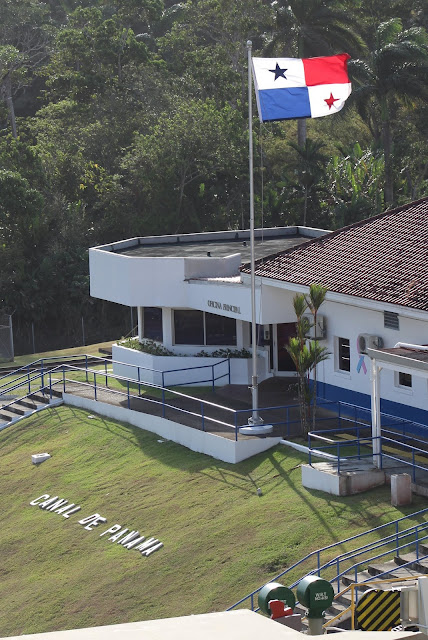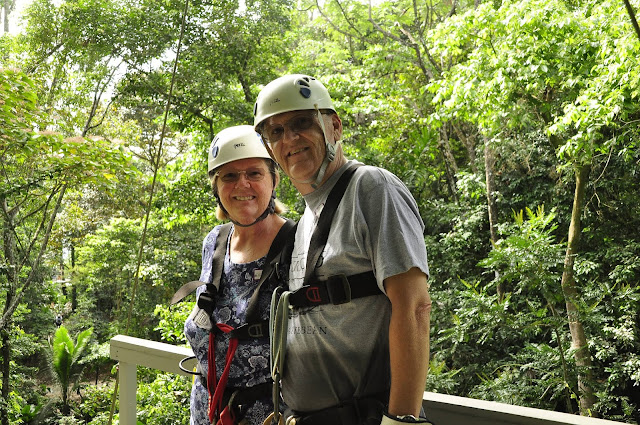For this year’s winter get-away, we did a 10 day Southern Caribbean cruise that included a Panama Canal turn around. We left from Fort Lauderdale, Florida,
and sailed for two days to get to Aruba. Originally we were supposed to go to the cruise line’s private island in the Bahamas, but a rough storm caused the
captain to skip that stop. We were happy (since we’d been to their island before) to get to Aruba earlier, giving us time to see the town before leaving on a
snorkeling excursion. Aruba was originaly a Dutch territory, so you can see the Dutch influence in the names and buildings. We passed Fort Zoutman that
is now a historical museum, but didn’t go in. After a little shopping in the main area of Oranjestad, we joined our snorkeling boat that took us to the end of
the island where the bigger resorts are located. The snorkeling was not the best that day; not the clearest water nor large variety of fish. But we did get
to swim by a sunken ship of the World War ll era. I don’t think there are lots of places to see a ship in that shallow of waters without scuba diving, so it was
interesting. We also enjoyed the warm sunshine!
 |
| Fort Zoutman |
 |
| Orjenstad shopping plaza |
Our next stop was Curacao. We had not booked an excursion there, but just opted to walk around the town. The island, also formerly a Dutch colony, has
a waterfront that was reminiscent of the Nyhaven area of Copenhagen with its brightly painted buildings and styling. We walked by a fish market where
the fishermen sell their fish right next to their boat in the canal. There was also a big produce marketplace, and of course plenty of retail shops. The
port area has an entrance with old walls from a fort.
 |
| Willemstad riverfront |
 |
| Curacao port |
 |
| Marketplace |
After another sea day we arrived at the Panama Canal. There are three locks going into Gatun Lake from the Caribbean side. A Panamanian captain takes
control and they hook the ship up to locomotives (called “mules") that guide the ship into each lock. Once inside a lock, the back gate is closed and the front
gate opened to let the water level raise the ship about thirty feet (all done by gravity and water flow). When this is completed, the ship moves ahead into the
next lock and the same process is completed to raise the ship again. After the third lock, the ship sails into Gatun Lake, a huge man-made lake. This lake
was made by damning the Chagres River and provides the water for the lock system. On a full transit the ship would sail through the lake and exit by
the three locks on the Pacific side, a process that takes 8 to 10 hours total. We exited the ship from the lake to take an excursion into Colonial Panama to
see the old city (plus views on modern Panama City) and go to the visitor’s center at the Miraflores Locks. It takes about 90 minutes to cross to the Pacific
side by bus (about 50 miles), the only place you can go from Atlantic to Pacific in that short a time! Along the journey we saw everything from shacks on
hillsides to a beautiful city of man high rise buildings. The colonial section of the city had old Spanish buildings and churches that were reminiscent
of San Juan, Puerto Rico. We walked around the area, then headed to the Miraflores Locks visitor’s center. There is a museum plus a great viewing area to
watch the locks in operation as ships pass through. We could see how smaller ships and boats are put in the same lock as a larger one when they want
passage. Their fees start at $2000, while large ships pay several hundred thousand dollars, depending on size. We could also see where the new
locks are (there was a large container ship in one) that opened in 2016 to accomodate much larger ships, as big as an aircraft carrier. Then we met our
ship that had exited the canal and docked in Colon. We were happy to just drive though Colon and get on the ship because Colon is an extremely dirty,
run-down city that didn’t look at all safe to walk around in. That was a bit surprising since it is a big port at the entrance to the Panama Canal.
 |
| Welcome to the Panama Canal |
 |
| Ship entering first lock |
 |
| View of second lock |
 |
| Old church in Colonial Panama |
 |
| Street in Colonial Panama |
 |
| View of Panama City |
 |
| Smaller boats sharing lock with ship |
 |
| Large container ship in new lock |
Our last stop on this cruise was Puerto Limon, Costa Rica. We booked and excursion to go zip-lining in the rainforest there. We took a bus along a
highway that had truckyards full of containers for companies like Dole and Chiquita that export bananas and other produce from the port. Within half
an hour we were in the rainforest and to our destination. After being strapped in harnesses and helmets and receiving some instruction, we were up in
the trees ready to begin. I thought it was awesome from the very first of the twelve cables we did, but Chuck took two or three to get past his nervousness.
They start you with shorter distances, then you get some pretty long rides. At each platform you’re hooked onto a cable around the tree until your turn to
hook onto the next cable. At one platform we saw an awesome sloth slowly climbing along a tree limb! Some people also saw tree frogs but I didn’t see
any. Did I mention that the rainforest was beautiful and the whole experience was amazing? It was - I definitely recommend it; nothing scary or strenuous
about it.
Our return to Fort Lauderdale took two sea days, then we hopped on a plane back to Salt Lake. We left the pleasant 80s of Florida to arrive at the end of one
of the worst snowstorms in many years. It was actually a snow day with closed schools, something that is very rare here. Thanks to our son, Jeff, for making
the slow trek to the airport to pick us up and get us home safely!
 |
| Costa Rican rainforest |
 |
| Me on the zipline |
 |
| Chuck zipping along |
 |
| It was lots of fun! |